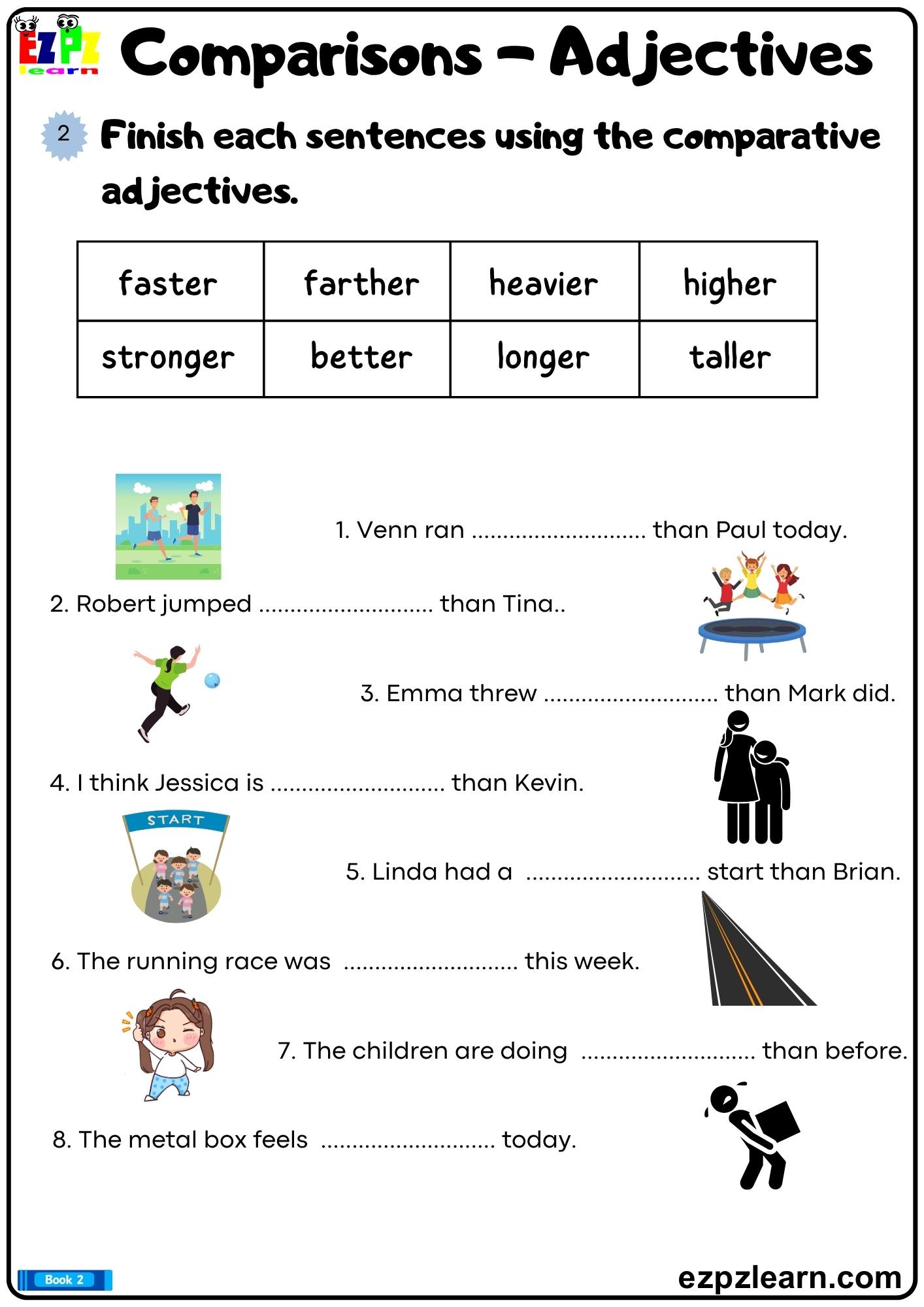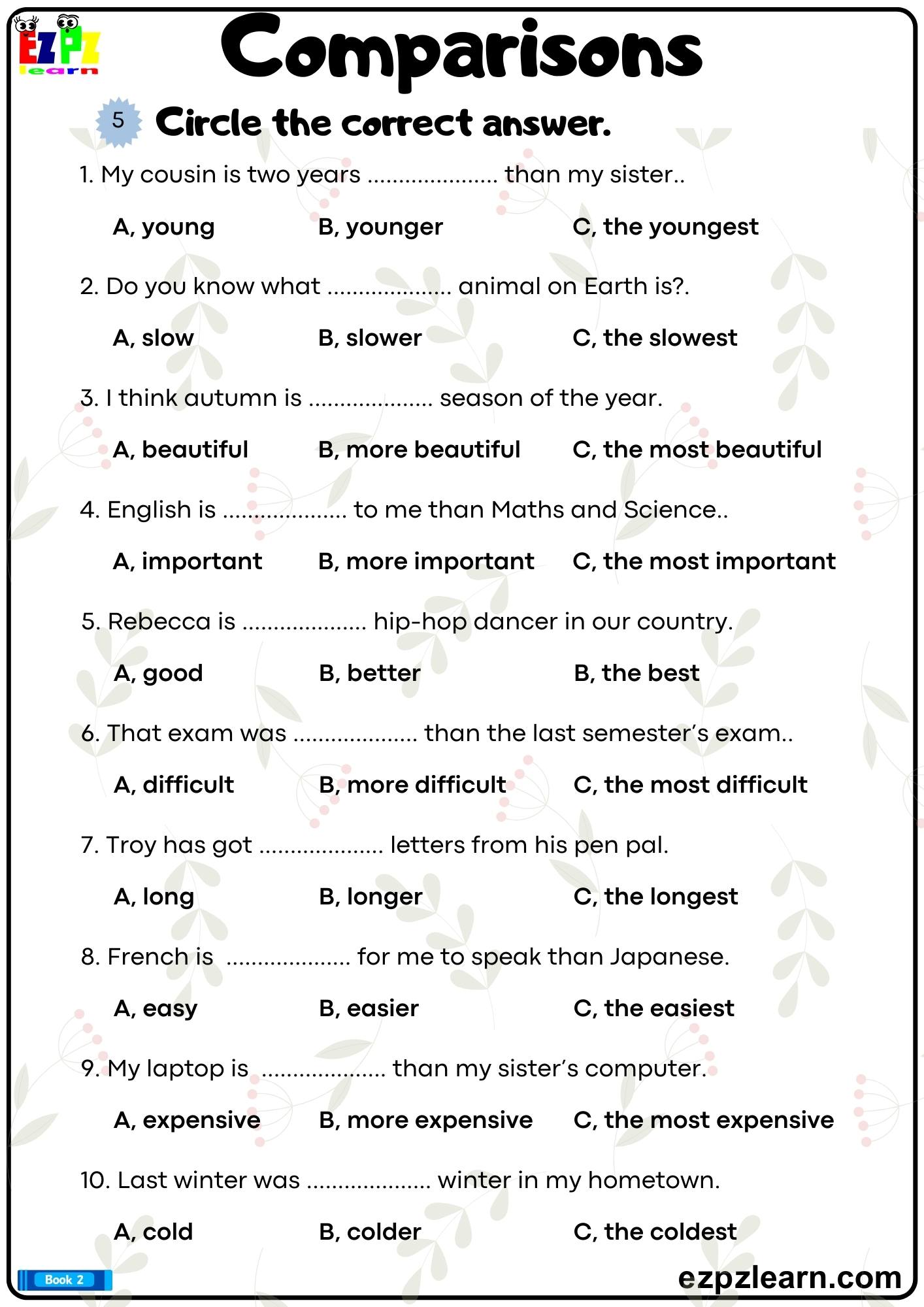Comparative Adjective Worksheets
Are you looking to boost your understanding of comparative adjectives? Or perhaps you’re an educator searching for effective resources to engage your students?
Whatever your reason, you’ve landed in the right place. Comparative adjective worksheets are not just tools; they are your gateway to mastering a crucial part of English grammar. Imagine expressing ideas more clearly, making your writing more compelling, and even enhancing your communication skills.
With the right worksheets, you can unlock all these benefits and more. Dive into our guide, and discover how these worksheets can transform your learning experience, making grammar not only approachable but also enjoyable. Don’t miss out on the chance to elevate your language skills effortlessly!
Purpose Of Comparative Adjective Worksheets
Comparative adjective worksheets help kids learn differences. They compare two things. For example, “taller” or “smarter.” These worksheets make learning fun. Kids see how words change meaning. They understand better and better.
Worksheets have pictures and examples. Kids match them with words. This helps memory. Kids find learning easy. They use these words in sentences. It’s great practice. Parents can help too. They ask questions and give hints.
Teachers use these worksheets in class. They play games with kids. Everyone enjoys learning together. These worksheets make English fun. Kids love using them. They learn faster this way.
Types Of Comparative Adjectives
Regular comparatives are easy to form. They usually add -er at the end. Words like “fast” become faster. It’s simple! Use regular comparatives to show change.
Some words change a lot. They don’t follow rules. “Good” becomes better. “Bad” changes to worse. These are irregular comparatives. They need to be memorized.
Two-syllable words can be tricky. Many use more or less before the word. “Careful” turns into more careful. But some words add -er like “happy” to happier. Watch for exceptions!
Creating Effective Worksheets
Clear learning objectives help students understand the goal of the exercise. They guide the focus of the worksheet. Objectives should be easy to understand. They should match the students’ level. This helps in achieving the desired learning outcomes.
Visual aids make learning fun and engaging. Pictures and diagrams can help explain concepts. They are useful for students who learn visually. Visual aids can also make worksheets attractive. They can help keep students interested.
Worksheets should have a mix of easy and hard tasks. This keeps students challenged but not overwhelmed. Start with simple questions. Then add harder ones. This helps in building confidence. Students feel accomplished as they progress.
Activities For Engagement
Interactive exercises make learning fun. Students compare objects using adjectives. They pick items from a box. Then describe them using comparative adjectives. The aim is clear. Encourage students to think and speak. They learn quickly and remember better.
Role-playing helps students understand adjectives. They act out different scenes. Each student gets a role. They describe actions and objects. Use adjectives like “bigger” or “smaller”. This way, learning is active and engaging.
Peer review sessions offer great learning. Students read each other’s work. They check for correct use of adjectives. Feedback is given. This boosts confidence and understanding. Students learn from each other. It fosters a positive learning environment.
Adapting For Different Age Groups
Young learners need fun and simple worksheets. Use bright colors and big pictures. Simple sentences work best for this age group. Children enjoy matching games and drawing activities. Use common words like “big,” “small,” “fast,” and “slow.” Keep exercises short to hold attention. Engagement helps with learning. Keep tasks varied and exciting.
Teens appreciate relatable content. Worksheets should include real-life scenarios. Use everyday situations like shopping or sports. Encourage group work to boost interaction. Include short stories or dialogues. These can make learning more engaging. Teens enjoy challenges that involve creative thinking. Balance fun with education. Keep their interest with varied activities.
Adults benefit from complex exercises. Use comparisons related to work or daily life. Include topics like travel or culture. Role-playing activities are effective. They help practice language in real situations. Adults appreciate clear explanations and examples. Offer tasks that require critical thinking. Use exercises that encourage discussion. This approach makes learning practical.
Assessing Student Progress
Feedbackhelps students know their strengths. It also shows areas to improve. Teachers can give notes on worksheets. This helps students understand better. They learn from their mistakes. Feedback is a key part of learning.
Tracking helps see progress. Students can compare their old work with new. They see how they have grown. It motivates them to do better. Tracking is a good way to measure success. It shows real improvement.
Self-assessment tools let students check their own work. They learn to be honest. Students can use checklists or charts. They see what they did well. It encourages self-correction. This helps them become better learners.
Incorporating Technology
Digital platformshelp students learn adjectives. Kids can find fun worksheets online. Teachers use these tools to make learning easy. Worksheets can be printed or done on tablets. Many websites offer free worksheets. Students enjoy colorful designs and friendly layouts. Worksheets come with pictures. Interactive features make learning fun. Students click buttons for answers. Worksheets can be shared with friends.
Online tools help students practice adjectives. Games make learning interesting. Kids drag and drop words. Quizzes test their skills. Tools give instant feedback. Correct answers get cheers. Wrong answers give hints. Students can try again. Teachers monitor progress. Reports show student improvement. Tools have bright colors. They use simple words. Students find them easy to use.
Mobile apps are great for learning. Kids love using phones or tablets. Apps have fun games. They teach adjectives through play. Students can learn anywhere. Apps give rewards for correct answers. Students compete with friends. Apps have levels to challenge kids. Teachers use apps to track learning. Students enjoy colorful animations. Easy navigation makes apps kid-friendly.

Credit: shop.luckylittlelearners.com
Common Challenges And Solutions
Teachers often face difficulties in engaging students with comparative adjective worksheets. Simplifying instructions and providing examples can enhance understanding and interest. Regular practice helps students grasp the concepts more effectively, making learning enjoyable.
Addressing Common Mistakes
Many students mix up adjectives. They might use the wrong form. Comparative adjectives compare two things. Words like “bigger” or “smarter” are examples. Some students forget to change the word. They say “more big” instead of “bigger.” It’s important to teach the rules clearly. Using simple examples helps. Worksheets should have clear instructions. Practice makes these rules easier to understand.
Overcoming Language Barriers
Non-native speakers face challenges. They might struggle with new words. Worksheets can help. Use pictures to show meanings. Visual aids can be very helpful. Students understand better with images. Worksheets should be simple and clear. Clear instructions are key. Repeat exercises improve learning. Consistent practice helps overcome barriers.
Encouraging Consistent Practice
Regular practice is important. Students need to use worksheets often. Short activities work best. They keep students engaged. Daily practice boosts confidence. Use fun exercises. Encourage students to try. Consistency makes learning easier. Worksheets should be varied. Keep students interested. Frequent practice builds skills faster.
Resources For Teachers
Teachers can find many online librariesfor worksheets. These libraries have different comparative adjective activities. Some websites offer free resources. Others might charge a small fee. Teachers can choose what’s best for their class. Using these libraries saves time. Teachers do not need to make their own worksheets. They can find worksheets for different grades.
Many websites offer printable templatesfor teachers. These templates are easy to use. Teachers can print them in color or black and white. Some templates allow teachers to add their own words. This makes the worksheet special for their class. Templates can help students learn better.
Some courses help teachers learn new ways to teach. These courses focus on comparative adjectives. Teachers can learn through videos and activities. Courses are usually online. Teachers can take them at home. This helps them learn at their own pace. Completing courses can improve teaching skills.

Credit: ezpzlearn.com

Credit: ezpzlearn.com
Frequently Asked Questions
What Are Comparative Adjectives In English?
Comparative adjectives are used to compare differences between two objects or people. They help describe how one noun differs from another. For example, in the phrase “taller than,” “taller” is the comparative adjective. It shows that one subject is more tall than another.
How Do You Form Comparative Adjectives?
To form comparative adjectives, you typically add “-er” to one-syllable adjectives. For adjectives with two or more syllables, use “more” before the adjective. For example, “big” becomes “bigger,” and “beautiful” becomes “more beautiful. ” Always remember the rules for spelling changes, like dropping the final “e.
“
Why Use Comparative Adjective Worksheets?
Comparative adjective worksheets help reinforce learning by providing practical exercises. They engage students in identifying and using comparative adjectives correctly. These worksheets enhance understanding through examples and activities, making it easier for learners to grasp concepts. They are great tools for both classroom and home learning.
Are There Exceptions In Forming Comparative Adjectives?
Yes, there are exceptions in forming comparative adjectives. Some adjectives are irregular, such as “good,” which becomes “better,” and “bad,” which becomes “worse. ” These irregular forms do not follow the standard rules. Understanding these exceptions is essential for mastering comparative adjectives.
Conclusion
Comparative adjective worksheets offer simple learning tools. They help students grasp differences. Easy exercises make learning fun and engaging. These worksheets boost confidence in using adjectives. Regular practice sharpens language skills. Students learn to compare objects and people effectively. Worksheets are accessible and suitable for all ages.
Teachers find them useful in classrooms. Parents can use them at home, too. They support continuous learning. A great resource for enhancing English skills. Ideal for non-native speakers wanting improvement. Start using comparative adjective worksheets today. See the difference in language learning.






